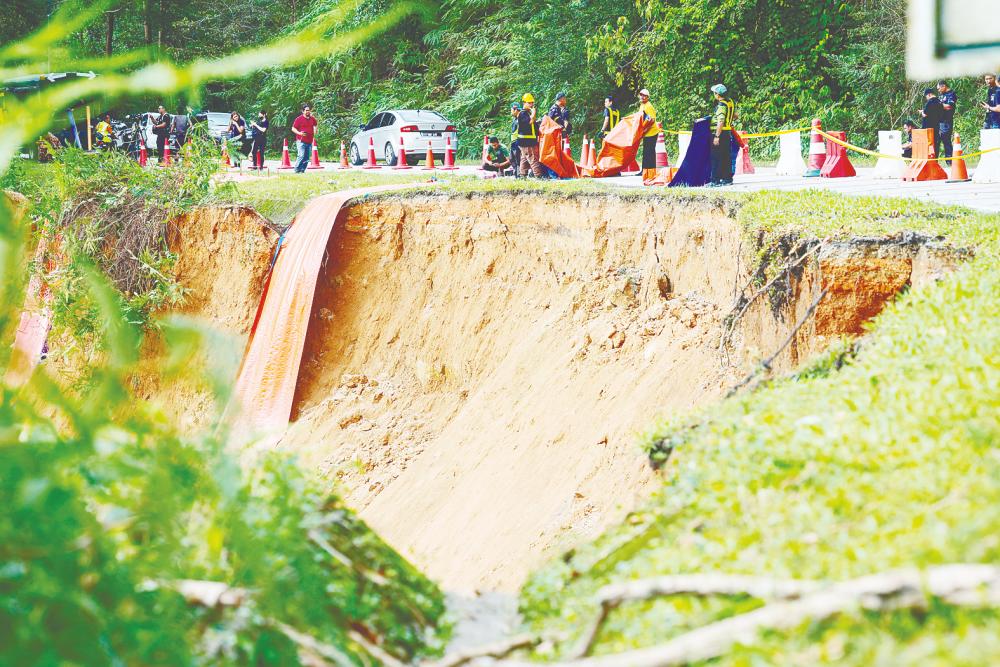ALMOST half of Peninsular Malaysia is occupied by hilly regions, which are a source of beauty and an environmental challenge.
Due to Malaysia’s tropical climate, the area is prone to heavy rains, which can trigger landslides and pose a significant threat to those living there.
As climate change makes rainfall even more intense and unpredictable, the frequency and severity of landslides have been increasing.
A question arises here: Is rainfall the only responsible factor for landslides in Malaysia? What about other manmade or natural factors?
Reducing landslide risks requires more than just relying on science and technology, it also needs the involvement of local communities and smarter urban planning.
One of the main reasons landslides are becoming more dangerous is the combination of climate change and unplanned urban development.
As the climate shifts, Malaysia is seeing more intense and frequent rainstorms, which make landslides more likely.
When rain soaks the ground, it weakens the soil, causing it to slide downhill, especially on steep slopes. Rainfall is a major trigger of landslides in Malaysia, particularly during heavy storms, but it is not the only cause.
Other factors, like steep slopes, weak or weathered soils, deforestation and poor land-use practices can also contribute significantly.
Unplanned construction and inadequate drainage systems on hillsides can further destabilise the land, increasing the likelihood of landslides.
People are building homes and developments on hillsides without proper planning or regulation. In areas like Cameron Highlands and Genting Highlands, rapid and unchecked construction has left slopes vulnerable to erosion.
A tragic example is the 2023 landslide in Batang Kali, Selangor, which claimed lives and property.
Additionally, vibrations from construction or seismic activity can exacerbate these risks. Together, these elements make Malaysia’s hilly regions especially prone to landslides, requiring comprehensive management strategies.
Scientists have been working on ways to predict where and when landslides are most likely to occur. By using computer models and studying the landscape, they can identify areas that are at high risk of landslides based on rainfall, soil conditions and how land is being used.
This technology gives authorities the opportunity to take action before a landslide happens.
However, while these models are great tools, they can only go so far. They rely on good and accurate data, which is not always available in many of Malaysia’s rural or developing areas. Also, even though technology can predict risks, it cannot stop people from building in dangerous areas or changing how the land is being used.
One of the most important and often overlooked pieces of the puzzle is the role of local communities. Integration of scientific technology and community awareness are among the most important landslide risk reduction approaches.
People living in high-risk areas need to be educated on the dangers of settling on steep slopes and be involved in efforts to reduce landslide risks. It is not enough for the government to issue warnings; communities need to be part of the solution. Local people can help monitor changes in the land and spot early signs of trouble, like cracks in the ground or shifts in vegetation.
People should be aware of hidden tributary locations, which generally cause underground seepage of rainwater that can trigger landslides. Similarly, sewage or pipeline leakage should be avoided in any slopy areas. Simple actions, such as installing proper drainage systems or maintaining trees and plants on hillsides, can make a big difference.
Trees, for example, help keep the soil stable with their roots, preventing erosion. In many parts of the world, community-led efforts have proven successful, and this could easily be replicated in Malaysia.
At the same time, the government must enforce stricter building regulations in high-risk areas. It should not be easy to build on unstable slopes, and construction should be limited in places where landslides are more likely.
Developers should be required to follow strict rules about drainage and land stability before being allowed to build in hilly regions.
Reforestation or planting more trees is another powerful way to reduce landslide risks. Many parts of highways have been reforested, and these need to be extended to other soil exposure places.
Forests or trees act as natural barriers, keeping the soil in place and soaking up excess rainwater. Efforts to restore forests in areas that have been deforested for agriculture or development should be prioritised.
If we invest in protecting and restoring our forests, it could go a long way in preventing future disasters.
Ultimately, reducing landslide risks in Malaysia will take a combination of scientific advances, smarter planning and active community participation. Relying solely on technology is not enough.
The government, local authorities and the people living in high-risk areas need to work together to create solutions.
If we focus on early warning systems, better building practices and maintaining our natural landscapes, we can help ensure the safety of those living in Malaysia’s beautiful but vulnerable hilly areas.
Furthermore, an advanced landslide early warning system based on artificial intelligence would be a novel approach to enhance landslide prediction and alert communities in high-risk areas.
Landslides do not have to be inevitable. By being proactive and combining the efforts of science, policy and community action, we can make a difference in reducing their impact and creating safer, more resilient communities.
The writer is a senior lecturer at the Department of Geology,
Faculty of Science,
Universiti Malaya. Comments: letters@thesundaily.com









